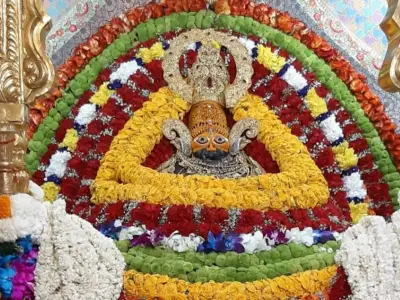History of Khatushyam
Khatushyamji, a highly revered deity in India, is worshipped as an incarnation of Barbarika, the grandson of Bhima, one of the Pandavas from the epic Mahabharata. The legend of Khatushyamji is intricately tied to the events of the Mahabharata, particularly the great war of Kurukshetra. His story is one of devotion, sacrifice, and divine blessings. Here is a brief account of his history:
Origins in the Mahabharata
Khatushyamji’s origin traces back to Barbarika, the son of Ghatotkacha (Bhima’s son) and Maurvi (the daughter of the demon Muru). From a young age, Barbarika was an exceptional warrior, blessed with extraordinary skills and divine weapons. He received three infallible arrows from Lord Shiva, which made him invincible in battle. Because of these arrows, he became known as Teen Baan Dhaari, the bearer of three arrows.
Barbarika’s Vow and Krishna’s Test
Before the battle of Kurukshetra, Barbarika decided to join the war. However, he vowed to fight on behalf of the losing side. This posed a unique problem, as it meant he would keep switching sides to support the weaker faction, which could ultimately lead to the destruction of both the Pandavas and the Kauravas.
Realizing the potential danger, Lord Krishna, disguised as a Brahmin, approached Barbarika to test his abilities. When Krishna inquired about his strength, Barbarika confidently stated that he could finish the war in moments using his three arrows. Intrigued, Krishna challenged Barbarika to demonstrate his skill by targeting a specific group of leaves on a tree. To further test him, Krishna hid one leaf under his foot. Remarkably, Barbarika’s arrow not only targeted all the leaves on the tree but also aimed at the leaf beneath Krishna’s foot, proving his immense power.
Seeing the threat Barbarika posed to the balance of the war, Krishna revealed his true identity and asked Barbarika how he planned to fulfill his vow. Barbarika replied that he would always fight for the weaker side. Krishna, understanding that this would lead to endless destruction, requested Barbarika’s head as a supreme sacrifice to protect dharma and ensure the Pandavas’ victory.
The Sacrifice
Being a true devotee of Krishna, Barbarika willingly agreed to sacrifice his head. Before the war commenced, Krishna asked for Barbarika’s head, and Barbarika, honored to serve the greater good, complied. As a final wish, Barbarika asked to witness the great battle of Kurukshetra. Krishna granted him this boon, and Barbarika’s head was placed on a hill from where he observed the entire war.
After the War
After the battle, Krishna blessed Barbarika’s head with divine powers. He declared that in the Kali Yuga, Barbarika would be worshipped by the name Shyam or Shyam Baba, and those who prayed to him with pure devotion would have their wishes fulfilled. Krishna gave him the name Shyam, which is also a name for Krishna himself, symbolizing the close bond between the two.
The Discovery and Establishment of Khatushyamji Temple
According to legend, after the events of the Mahabharata, Barbarika’s head was submerged in the river Rupavati for many years. One day, a cow belonging to a devotee began offering its milk at a particular spot daily. Upon investigation, Barbarika’s head was discovered buried in the soil. This site is now believed to be in Khatu, a village in the Sikar district of Rajasthan.
The head was enshrined in the village of Khatu, where a grand temple was built in its honor. Today, the Khatushyamji Temple is one of the most famous pilgrimage sites in Rajasthan. Devotees from across India visit the temple to seek blessings, believing in the deity’s power to fulfill wishes and alleviate suffering.
Worship and Devotion
Khatushyamji is worshipped as a god of compassion, and it is believed that those who approach him with true devotion and a pure heart will have their prayers answered. He is often referred to as the “God of Kali Yuga,” as his blessings are considered especially potent in this age. Devotees commonly chant “Hare Ka Sahara, Shyam Hamara” (Shyam is our savior) as an expression of their faith.
Several festivals are celebrated in honor of Khatushyamji, with the Phalguna Mela, held in February/March, being the most significant. During this festival, thousands of devotees flock to the temple to perform rituals and seek divine grace.
Symbolism and Legacy
Khatushyamji stands as a symbol of selfless sacrifice, devotion, and the protection of righteousness. His story emphasizes the importance of humility and alignment with dharma, even for the most powerful warriors. His devotees believe that like Lord Krishna, Khatushyamji continues to guide and protect them, offering solace in times of need.
The legacy of Khatushyamji lives on through his devotees, making him one of the most cherished and venerated deities, particularly in northern India, where millions continue to find spiritual comfort and strength through their devotion to him.

